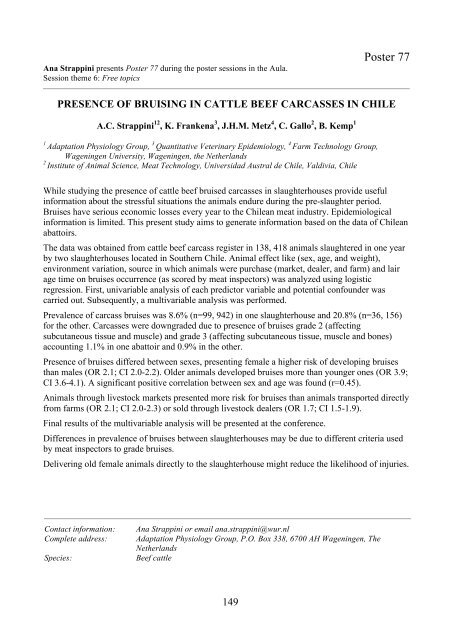Acknowledgements Book of abstracts - Publicaties - Vlaanderen.be
Acknowledgements Book of abstracts - Publicaties - Vlaanderen.be
Acknowledgements Book of abstracts - Publicaties - Vlaanderen.be
You also want an ePaper? Increase the reach of your titles
YUMPU automatically turns print PDFs into web optimized ePapers that Google loves.
Ana Strappini presents Poster 77 during the poster sessions in the Aula.<br />
Session theme 6: Free topics<br />
149<br />
Poster 77<br />
PRESENCE OF BRUISING IN CATTLE BEEF CARCASSES IN CHILE<br />
A.C. Strappini 12 , K. Frankena 3 , J.H.M. Metz 4 , C. Gallo 2 , B. Kemp 1<br />
1 Adaptation Physiology Group, 3 Quantitative Veterinary Epidemiology, 4 Farm Technology Group,<br />
Wageningen University, Wageningen, the Netherlands<br />
2 Institute <strong>of</strong> Animal Science, Meat Technology, Universidad Austral de Chile, Valdivia, Chile<br />
While studying the presence <strong>of</strong> cattle <strong>be</strong>ef bruised carcasses in slaughterhouses provide useful<br />
information about the stressful situations the animals endure during the pre-slaughter period.<br />
Bruises have serious economic losses every year to the Chilean meat industry. Epidemiological<br />
information is limited. This present study aims to generate information based on the data <strong>of</strong> Chilean<br />
abattoirs.<br />
The data was obtained from cattle <strong>be</strong>ef carcass register in 138, 418 animals slaughtered in one year<br />
by two slaughterhouses located in Southern Chile. Animal effect like (sex, age, and weight),<br />
environment variation, source in which animals were purchase (market, dealer, and farm) and lair<br />
age time on bruises occurrence (as scored by meat inspectors) was analyzed using logistic<br />
regression. First, univariable analysis <strong>of</strong> each predictor variable and potential confounder was<br />
carried out. Subsequently, a multivariable analysis was performed.<br />
Prevalence <strong>of</strong> carcass bruises was 8.6% (n=99, 942) in one slaughterhouse and 20.8% (n=36, 156)<br />
for the other. Carcasses were downgraded due to presence <strong>of</strong> bruises grade 2 (affecting<br />
subcutaneous tissue and muscle) and grade 3 (affecting subcutaneous tissue, muscle and bones)<br />
accounting 1.1% in one abattoir and 0.9% in the other.<br />
Presence <strong>of</strong> bruises differed <strong>be</strong>tween sexes, presenting female a higher risk <strong>of</strong> developing bruises<br />
than males (OR 2.1; CI 2.0-2.2). Older animals developed bruises more than younger ones (OR 3.9;<br />
CI 3.6-4.1). A significant positive correlation <strong>be</strong>tween sex and age was found (r=0.45).<br />
Animals through livestock markets presented more risk for bruises than animals transported directly<br />
from farms (OR 2.1; CI 2.0-2.3) or sold through livestock dealers (OR 1.7; CI 1.5-1.9).<br />
Final results <strong>of</strong> the multivariable analysis will <strong>be</strong> presented at the conference.<br />
Differences in prevalence <strong>of</strong> bruises <strong>be</strong>tween slaughterhouses may <strong>be</strong> due to different criteria used<br />
by meat inspectors to grade bruises.<br />
Delivering old female animals directly to the slaughterhouse might reduce the likelihood <strong>of</strong> injuries.<br />
Contact information: Ana Strappini or email ana.strappini@wur.nl<br />
Complete address: Adaptation Physiology Group, P.O. Box 338, 6700 AH Wageningen, The<br />
Netherlands<br />
Species: Beef cattle
















